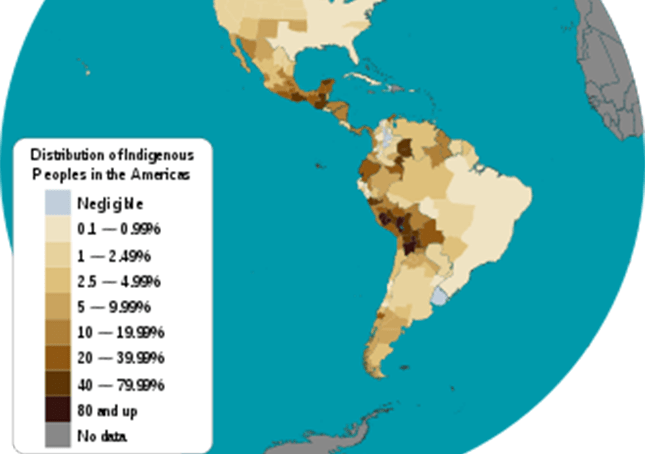Indigenous peoples of the Americas

The indigenous peoples of the Americas are the inhabitants of the Americas before the arrival of the European settlers in the 15th century, and the ethnic groups who now identify themselves with those peoples.
Although some indigenous peoples of the Americas were traditionally hunter-gatherers—and many, especially in the Amazon basin, still are—many groups practiced aquaculture and agriculture. The impact of their agricultural endowment to the world is a testament to their time and work in reshaping and cultivating the flora indigenous to the Americas.
Although some societies depended heavily on agriculture, others practiced a mix of farming, hunting and gathering. In some regions the indigenous peoples created monumental architecture, large-scale organized cities, city-states, chiefdoms, states, kingdoms and empires. Some had varying degrees of knowledge of engineering, architecture, mathematics, astronomy, writing, physics, medicine, planting and irrigation, geology, mining, sculpture and goldsmithing.
Many parts of the Americas are still populated by indigenous peoples; some countries have sizable populations, especially Bolivia, Canada, Ecuador, Guatemala, Mexico, Peru and the United States. At least a thousand different indigenous languages are spoken in the Americas.
Some, such as the Quechuan languages, Aymara, Guaraní, Mayan languages and Nahuatl, count their speakers in millions. Many also maintain aspects of indigenous cultural practices to varying degrees, including religion, social organization and subsistence practices. Like most cultures, over time, cultures specific to many indigenous peoples have evolved to incorporate traditional aspects but also cater to modern needs. Some indigenous peoples still live in relative isolation from Western culture and a few are still counted as uncontacted peoples.
Application of the term “Indian” originated with Christopher Columbus, who, in his search for India, thought that he had arrived in the East Indies. Eventually, those islands came to be known as the “West Indies,” a name still used. This led to the blanket term “Indies” and “Indians” (Spanish: indios; Portuguese: índios; French: indiens; Dutch: indianen) for the indigenous inhabitants, which implied some kind of racial or cultural unity among the indigenous peoples of the Americas. This unifying concept, codified in law, religion and politics, was not originally accepted by the myriad groups of indigenous peoples themselves, but has since been embraced or tolerated by many over the last two centuries.[34] Even though the term “Indian” generally does not include the culturally and linguistically distinct indigenous peoples of the Arctic regions of the Americas—such as the Aleuts, Inuit or Yupik peoples, who entered the continent as a second, more recent wave of migration several thousand years before and have much more recent genetic and cultural commonalities with the aboriginal peoples of the Asiatic Arctic Russian Far East—these groups are nonetheless considered “indigenous peoples of the Americas.”
The term Amerindian (a blend of “American and Indian”) and its cognates find preferred use in scientific contexts and in Quebec, the Guianas, and the English-speaking Caribbean.
In Canada, indigenous peoples are commonly known as Indigenous Canadians—and sometimes Aboriginal Canadians, though the term has fallen out of favour in recent times[39]—which includes not only First Nations and Arctic Inuit, but also the minority population of Métis people,[40][41] a First Nations-European mixed race who identify culturally and ethnically with indigenous peoplehood.
The Métis people of Canada can be contrasted, for instance, to the American Indian-European mixed race mestizos (or caboclos in Brazil) of Hispanic America who, with their larger population (in most Latin-American countries constituting either outright majorities, pluralities, or at the least large minorities), identify largely as a new ethnic group distinct from both Europeans and Indigenous Americans, but still considering themselves a subset of the European-derived Hispanic or Brazilian peoplehood in culture and ethnicity (cf. ladinos).
Among Spanish-speaking countries, indígenas or pueblos indígenas (‘indigenous peoples’) is a common term, though nativos or pueblos nativos (‘native peoples’) may also be heard; moreover, aborigen (‘aborigine’) is used in Argentina and pueblos originarios (‘original peoples’) is common in Chile. In Brazil, indígenas or povos indígenas (‘indigenous peoples’) are common of formal-sounding designations, while índio (‘Indian’) is still the more often-heard term (the noun for the South-Asian nationality being indiano). Aborígene and nativo is rarely used in Brazil in Amerindian-specific contexts (e.g. aborígene is usually understood as the ethnonym for Indigenous Australians). The Spanish and Portuguese equivalents to Indian, nevertheless, could be used to mean any hunter-gatherer or full-blooded Indigenous person, particularly to continents other than Europe or Africa—for example, indios filipinos.
Indigenous peoples of the United States are commonly known as Native Americans or American Indians, as well as Alaska Natives.
